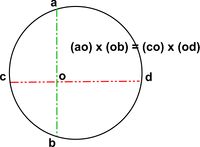Intersecting Chords: Difference between revisions
From DT Online
(Added chords diagram) |
m (Added link to J.E.Gordon) |
||
| Line 14: | Line 14: | ||
* but, for small deflections, Δ<sup>2</sup> will be negligible | * but, for small deflections, Δ<sup>2</sup> will be negligible | ||
* so R = cd<sup>2</sup> ÷ 8 x Δ | * so R = cd<sup>2</sup> ÷ 8 x Δ | ||
''(see ‘Structures’ by J.E.Gordon ISBN 0 14 02.1961 7)'' | ''(see ‘Structures’ by [http://en.wikipedia.org/wiki/J.E._Gordon J.E.Gordon] ISBN 0 14 02.1961 7)'' | ||
Revision as of 10:04, 8 November 2014
This theorem relates to a characteristic of a cyclic quadlitateral, the diagonals of which are two intersecting chords of the circumscribing circle.
It can be useful when measuring the radius of bending of a deflected beam, for example, if one of the chords is taken to be the length of the beam
e.g.
- set up a strip of material as a simple beam
- note the distance between supports (cd)
- apply a central load to make it bend - or ‘deflect’(Δ) - therefore co = od = ½cd
- measure the deflection (ob)
Bending Radius (R) can be calculated as follows:
- ao x ob = co x od
- (2R-Δ) x Δ = ½cd x ½cd
- but, for small deflections, Δ2 will be negligible
- so R = cd2 ÷ 8 x Δ
(see ‘Structures’ by J.E.Gordon ISBN 0 14 02.1961 7)
